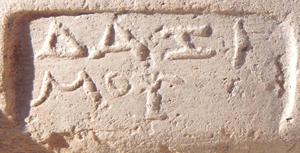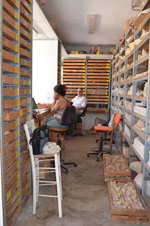
Alexandria Amphora Study Centre


CEAlex - UAR 3134
| Français | English |

| Introduction | Amphorae | Stamped Handles | Lexicon of Rhodian stamp dies | Bulletin amphorique | General Bibliography | On-line resources | Site map | Update |
Stamped Handles
Gonca Cankardeş-Şenol, Pr. Dr. at the Ege University of Izmir
Gökmen Elmali, PhD, Ege University of Izmir
Jean-Yves Empereur, Member of CEAlex (Centre for Alexandrian Studies), CNRS
Kaan Şenol, Pr. Dr. at the Ege University of Izmir
We are pleased to present the online publication of amphora stamps from Delos. We begin with the 1369 Rhodian stamped handles and small groups (i.e. in addition to the Knidians and Rhodians). Documentation (reading, photography, rubbings) was carried out by the four undersigned during several stays in Delos. The database was completed by Dr. Gökmen Elmali, then a PhD student at Ege University in Izmir, the identification of the matrices was carried out with the supervision on Pr. Gonca Cankardeş-Şenol, with the online uploading being done by Danielle Guiraudios, Computer Scientist at the CEAlex.
The collection which Virginia Grace had numbered and classified from TD 1 to TD 6789 and that Jean-Yves Empereur had continued to increase using the same system up to TD 8186 (1) was placed in wooden cabinets with drawers manufactured ad hoc, following a standard developed by the American team (as in the Agora and the National Museum in Athens as well as in the Graeco-Roman Museum in Alexandria). Placed in the southern storeroom of the southern courtyard of the Delos Museum, this furniture was transported and rearranged in an admirable manner by Panagiotis Hatzidakis, then Ephoros of the Cyclades, in the northern part of the storeroom. The amphora handles are easy to locate, and working conditions are excellent, with airy workspaces overlooking the museum's south courtyard. We would like to thank the Greek authorities for their hospitality, and in particular the staff of the Ephorate of Antiquities of Cyclades in Delos, as well as the École Française d'Athènes in the person of its Directors, Alexandre Farnoux and now Véronique Chankowski, for the facilities we enjoyed throughout our stays on the island.
The Rhodian group from Delos, which occupies 34 drawers to date, is presented here in a simplified form that includes for each handle the TD number, possibly the inventory number of the museum and/or excavation, the storage drawer, the name of the maker or eponym, the month, the attribute, a transcription of the inscription, the date and any publication references, a photograph, possibly a rubbing, and the matrix number: this matrix number, linked to the TD number, constitutes the stamp's true identity according to the system adopted on the website www.amphoralex.org (2).A button allows to switch from the present Delian database to the general Amphoralex database, where will be found the expanded matrix record for the Delian stamp in question. It should be noted that some Delian records do not have this matrix number, when the matrix has not been recognised, or when the stamp is illegible or difficult to read. We may also find ourselves faced with a new die, such as TD 6260 where we deciphered, perfectly legible, the name of a hitherto unknown fabricant, Dazimos (3) (fig. 2). In this case, we are adding a new record to the Amphoralex database.

Fig. 2 : Dazimos, a new Rhodian fabricant, Photo Kaan Şenol, CEAlex archives.
The other groups are divided according to two different hierarchies :
By place of production. V. Grace had separated the handles according to their type: Rhodian, Knidian, Latin (for this last category, the work fell to E. Lyding-Will) (4), the ‘miscellaneous’ (especially Parmeniskos, Nikandros, Pamphylia (5), Sinope, etc. with a few Roman ones mixed in), the Chian, the Koan and the Thasian. Almost all of the smaller groups are presented in this database, with a matrix number that corresponds to the system developed in 1986 (6) and which is developed here for the first time for each of these groups, with a view to a systematic corpus of matrices in the Amphoralex database by excavation context.
The amphora handles from some excavations have been kept in separate drawers: the handles from the excavation of the Stoa of Philip V, and those from the excavation of the House of Hermes (1953) (7). It should be noted that the amphora handles discovered in excavations after 1990 were not placed in the drawers for amphora handles, but remained with the rest of the artefacts from the excavation. The amphora handles from these recent excavations do not bear a TD number either, so the continuous numbered series has been interrupted.
Finally, it should be noted that most of the Rhodian dies were published by Pr. Gonca Cankardeş-Şenol in a series of four-volume lexicon of eponym dies stamped on Rhodian amphorae (all published) and four-volume lexicon on fabricant dies stamped on Rhodian amphorae (two volumes published to date).
(1) The collection grew steadily during the excavations, from 5952 in Grace 1952, p. 517, to 7771 in Empereur 1982, p. 223, end of note 19, to a figure of 8186 in 1990. ↪︎
(2) In this database, there are to date 7955 dies online of Rhodian eponyms and 4669 of Rhodian makers. It is estimated that, in time, the number of manufacturer matrices will be approximately the same as the number of eponyms, giving a total of around 13,000 different matrices for the Rhodian group. This database is thanks to Gonca Cankardeş-Şenol and her team with the technical support of Danielle Guiraudios. ↪︎
(3) On this unexpected name in Rhodes, we quote the remarks of late Claude Brixhe : ‘Dazimos is well known, the name is attested in Greek documents mainly in southern Italy, and on the other side of the Adriatic Sea, in Illyria and Acarnania, from the 7th/6th to the 2nd century BC, see Fraser, Matthews, LGPN III.A. It is also found in Messapian (a non-Greek and non-Latin language located in the heel of the Italic boot), cf. C. De Simone, S. Marchesini, Monumenta linguae Messapicae, Wiesbaden 2002, II, 91, s.v. Dazimos. Origin? Apparently italic. » ↪︎
(4) Lyding-Will 1970. ↪︎
(5) cf. Grace 1973 and Brixhe 2013. ↪︎
(6) Empereur, Guimier-Sorbets 1986, especially p. 129. See an application to the Nikandros Group, G. Cankardeş-Şenol « Nikandros Group: Matrix Studies on the Amphora Stamps of the Group », OLBA XVIII, 2010, p. 125-139. ↪︎
(7) Marcadé 1954. ↪︎
Bibliographical abbreviations for publications on amphora stamps from Delos
Brixhe 2013
C. Brixhe, avec la collaboration de Gonca Cankardeş-Şenol, Timbres amphoriques de Pamphylie, Études Alexandrines 23, AmphorAlex 2, Alexandrie 2012.
Bruneau et al. 1970
Ph. Bruneau et al., L’îlot de la Maison des Comédiens, Exploration archéologique de Délos, 27, 1970.
Empereur 1982
J.-Y. Empereur, « Les anses d’amphores timbrées et les amphores : aspects quantitatifs », BCH 106, 1982, p. 219-233.
Empereur, Guimier-Sorbets 1986
J.-Y. Empereur, A.-M. Guimier-Sorbets, « Une banque de données sur les vases conteneurs – Amphores et lagynoi - dans le monde grec et romain », Recherches sur les amphores grecques (J.-Y. Empereur, Y. Garlan éd.), BCH, Supplément 13, 1986, p. 127-141.
Grace 1952
V. Grace, « Timbres amphoriques trouvés à Délos », BCH 76, 1952, p. 514-540.
Grace 1970
V. Grace, « Les timbres amphoriques grecs », in Bruneau et al 1970, p. 277-382.
Grace 1973
V. Grace, « Imports from Pamphylia » Études Déliennes, BCH, Supplément 1, 1973, p.183-208.
Lyding-Will 1970
E. Lyding-Will, « Les timbres amphoriques latins », in Bruneau et alii 1970, p. 383-386.
Marcadé 1954
J. Marcadé, « Chronique des fouilles en 1953 : Délos », BCH 78, 1954, p. 218-220.
 Fig.1 - La réserve avec les tiroirs d'anses d'amphores timbrées de Délos. Cliché Kaan Şenol. Archives CEAlex
Fig.1 - La réserve avec les tiroirs d'anses d'amphores timbrées de Délos. Cliché Kaan Şenol. Archives CEAlex